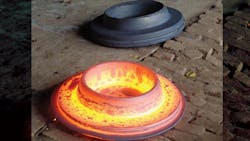Process Mapping/Simulation Combo Succeeds for Open-Die Set Up
The value of forging process simulation is not simply in how it optimizes production sequences, but in what information it reveals to the operators about the forging equipment and processes. For example, in 2014 a new, 100,000-mt open-die press was inaugurated at GIVA Corp.’s Forgiatura a Vienna operation near Milan, Italy. To maximize its commercial potential, GIVA established a cross-functional engineering group of experts in forging, Ni-base alloy metallurgy, and computer simulation modeling. The team, including process engineer David Smith, metallurgist David Colnago, and FEA engineer Daniele Brunelli, worked to develop modeling technics and laboratory characterization for the Ni-base alloys involved in the plant’s production of large industrial valves for oil and gas applications. Recently, they outlined the results of their first operational trials for producing 1-m O.D. discs.
Their process development method used theoretical concepts of process mapping integrated with computer simulation modeling, which were easily applied to the new press’s process control system, and reproducible for forging parameters in the final computer model optimization. They were able to control the alloy grain size and precipitate structure (delta phase) without tears or cracks during the final forging process.
The next steps were to integrate the engineering concepts and procedures for other Ni-base alloys and increase the size of the discs to two meters OD.
The discs being formed are part of the assembly of an industrial turbine engine. Specifically the 60- or 50-Hz turbine engine runs at 3,600 or 3,000 RPM and is connected to a main power grid. Because these parts run at such high speeds and temperatures, Ni-base alloy materials are selected to endure the high cycle conditions.
Ni-base alloys resist distortion in high-temperature environments, but that quality also makes them more difficult to forge, requiring higher-than-normal press power to achieve the final shape. In addition, the alloys are more prone to adiabatic heat-up and tearing if not handled properly during forging.
The engineering team noted that these issues demonstrate the first law of thermodynamics: the more energy applied to the forging process, an equal amount will be reflected as heat, mechanical tearing, and/or structural changes in the workpiece. While some of these effects are necessary, some are undesirable.
The GIVA engineers applied Process Mapping (PM) techniques to define the process more closely. Specifically, energy distribution curves revealed by PM helped to explain the hot forming process. The parameters used to explain the concepts were the same (strain, strain-rate and temperature) as those used in computer simulation software. Therefore, a decision was made to incorporate/integrate the PM methodology with Finite Element Modeling (FEM) to aid in predicting the necessary and undesirable effects of the forging process.
Computer simulation of the manufacturing process (SIM) uses finite element analysis and CAD-CAM tools to project the process as a function of strain, strain rate, and temperature. Using SIM, the entire forging procedure can be simulated using iso-curves to determine physical characteristics that include material flow, die life, 2D and 3D strain-rate maps, and 2D and 3D thermal maps. This made it possible to predict the process effects prior to implementation or investment in raw material and manufacturing cost.
For a given product design, this tool can help to reduce the time and cost of setting up a forging process. The cost of the manufacturing can be significant, especially when evaluating closed-die or semi closed-die forging, which involve issues of die filling, high-strain regions, or high potential laps areas. Knowing this information prior to manufacturing avoids machining and re-machining of dies and retrials of the forging process.
PM takes finite-element analysis a step further in developing hot forming procedures. It uses the strain rate and strain and temperature profiles to determine areas defined unstable, and determines the optimal process variables needed for manufacturing.
As noted, thermodynamic equilibriums must be met during forging, and the ways that the energy is distributed is important to the success of the process. If the press energy is distributed in a detrimental way, forging defects like surface tears, internal cracking/tearing and unwanted structures may form. PM defines the strain-rates, strain and temperatures when these problems are most likely to occur.
When profiling and modeling a forging process, critical variables like stress-strain, stress-strain rates and temperature influence the final structure of the part. Integrating potential risk areas from PM into SIM modeling adds more clarity to predicting the outcome of the forging process. High-risk areas where defects such as tears may occur can be easily determined by means of color coding and three-dimensional imaging.
The GIVA engineering team developed and used their SIM-PM approach to determine if any modifications were needed to their open-die forging process. As noted, the goal was to save cost and time in determining the viability of forging specific products, and it succeeded in identifying production risks for further evaluation.
With the results of their simulations, manufacturing procedures were chosen to avoid processing variables that might trigger the predicted defects. These procedures include selecting appropriate Ni-based alloy forging methods like die temperature control, forging temperature, thermal cycle times, and lubrication methods, among some others. With their results, it was determined that it would be possible to proceed with forging the Ni-alloy discs.
Exporting the SIM-PM conclusions to the production phase had to be done carefully, making all involved well aware of the process procedures and how those parameters were to be implemented. Detailed instructions were reviewed and in some cases mock-ups were used to train the manufacturing personnel. Also, specific parameters were supplied to the press operators and programmed into its process control program.
The forging trials that followed were successful.
About the Author
Robert Brooks
Editor/Content Director - Endeavor Business Media
Robert Brooks has been a business-to-business reporter, writer, editor, and columnist for more than 20 years, specializing in the primary metal and basic manufacturing industries. His work has covered a wide range of topics including process technology, resource development, material selection, product design, workforce development, and industrial market strategies, among others.
Currently, he specializes in subjects related to metal component and product design, development, and manufacturing—including castings, forgings, machined parts, and fabrications.
Brooks is a graduate of Kenyon College (B.A. English, Political Science) and Emory University (M.A. English.)

